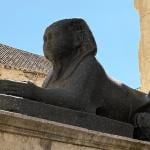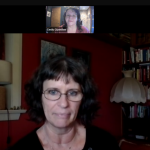XV. The Work Continues, 4
As the caterpillar chooses the fairest leaves to lay her eggs on, so the priest lays his curse on the fairest joys.
William Blake
“Seamus, what can you tell us about this Gaelic gospel?” I asked.
“It is a translation of a gospel originally composed in Greek,” Seamus replied. “I’m not as familiar with all the Gnostic writings as some of you, but the story told here goes back to the era of Jesus, more or less.”
“Is it about Simon Magus?” I asked.
“Yes, but here he’s called Simon Magnus, Simon the Great,” Seamus replied. “The gospel begins with a creation myth about the fragmentation of the primordial light and its captivity within matter. Then it gets into the story of Simon and Helen, which is rather powerful.”
.(Here Seamus did read some passages from his rough draft. But, since we later produced a more polished translation, I prefer to include excerpts from it elsewhere in this book.)
Seamus finished up by saying, “The end of this gospel does give us a date for its composition. It reads like so:
In the ninth century[1] great wars broke out all over the world, and brother fought with brother. Many of the chosen, as well as others, fled for refuge to this island of the Hibernians, beyond the island of the Britons. Here they who worship the Crucified One as a god have lately come, telling lies about us, who are the chosen. Wherefore I, Cornelius Hieronymus Maro, have copied the writings of the chosen in this year of the foundation of the city of Rome 1185, passing on what I received just as I received it, that knowledge of the Light may be kept for those who have eyes to see it. Peace be to all on whom the name of knowledge rests.
Seamus commented, “The date here is A.D. 432, the traditional date for the arrival of St. Patrick”
“That does explain how there could be Gnostics in Ireland,” I said. “So, Angie, what can you tell us about this gospel for Witches?”
Angie replied, “It is so radical! There are a lot of places where I have no idea what she’s talking about. That’s where Andy was especially helpful”
“She?” Sherman asked.
“Yes, the author is a woman, named Diana. She identifies herself unequivocally. It’s a Gospel of Diana in several senses — Diana as Queen of the Witches is another. But its protagonist is a woman prophet named Aradia, I think the same one that Leland gathered some traditions about.
“Most of you have had a chance to read through my first pass. Right now I’m going to talk about dating it, not about content. I have a rough timeline for the stages in which it was written. Aradia lived in the twelfth century and must have died about the year 1180. The gospel says that both her daughter, Diana, and her other followers secretly carried on her work. The gospel is prefaced by a note from that Diana to her own daughter, whom she had named Aradia; it would have been written early in the thirteenth century and gives us some clues about how this `gospel’ came to be written.
“The preface reads like so:
To my beloved daughter, Aradia, greetings.
I am overjoyed at your determination to preserve your grandmother’s teachings and practices. I am sending herewith, in the pouch of our trusted Antonio, the memoirs you asked me for.
As you know, I was not yet fifteen when your grandmother took her coven and began her public teaching. It would have been far too dangerous for me to have traveled with them. Whenever they returned to my father’s house, I listened carefully and pieced together as much as I could of what your grandmother had said and done. Nonetheless, my knowledge is surely incomplete. You have done well to seek out others who knew her. The memories of the other Diana are especially precious.
After your grandmother was killed by the Cardinal, Lucca was no longer safe for me. The Cardinal’s men were searching for me and for all of our sisters and brothers in the Lady, hoping to silence us forever. Hence our family spirited me away to our relatives here in Perugia, where I have lived under an assumed name. I was fortunate to be betrothed to your father. His family was one of the few who kept to the old ways and remembered their lineage back to the Roman clans and thus to the Gods. He has always treated me with great kindness and respected our ways.
I charge you, my love, in the name of the Lady, to preserve these writings with your life and to pass them on to your own daughter or granddaughter–as if you needed such a charge. Until we meet again, I bid you farewell and blessed be.
Witness my seal: DdL
(At this point Angie gave us her analysis of the stages in which the gospel had been written. It would be tedious here. She could identify at least five different women who had contributed to the writing. She also read some excerpts that I prefer to give from our more polished translation later in this book.)
Angie than continued, “The name Ubaldo Allucingoli appears in one passage. He became Pope Lucius III and founded what later became the Holy Office of the Inquisition. It’s never been clear why he did that, but perhaps now we know. One final passage may give us a date for the last version of this:
In these last times of civil war, when patriots have risen to reclaim power that the black priests have usurped, I, Diana, have made myself known as a teacher among the Witches of Tuscany. I am from the family of Aradia. I know the Mysteries handed down by my grandmothers’ grandmothers.
“I think the reference here is to the Italian Civil War,” Angie said. “I haven’t yet thought of a reason why that dating couldn’t work.
“Let me mention one other problem. This gospel presents a radical and positive theology of sexuality. It is written in the Tuscan dialect, the language of Dante and Petrarch, but the final author, the Ultimate Diana, as I think of her, is very blunt. She doesn’t use euphemisms, equivalent to our ‘made love’ or ‘slept with’ or even ‘had sex with.’ She uses the Italian word that is equivalent to our, ah, f-word. Her intent is to redeem that word, to turn it into a holy word, a blessing rather than a curse. I do understand that. But I can’t see how to accomplish that in English. If I use the f-word every place where it’s the correct translation, very few readers would understand her purpose. Most people would consider this to be merely a blasphemous joke. I’m not sure how to proceed.”
“Is her theology clear if you use euphemisms?” Alan asked.
“Yes, I believe it would be. But the translation will lose some of the emotional power that word creates,” she replied.
“Hmm,” Brendan mused. “What if you did a translation for publication using euphemisms, but we offered to provide the literal translation to anyone who asked for it?”
“That might work,” Angie said. “I could do it both ways.”
At this point, because it was rather late, Megan asked us to disperse, which everyone did. However, she took hold of my arm, drew me into the kitchen, and said, “Eddie, are you ready now to come circle with us? Our next full moon circle is tomorrow. I’m pretty sure the coven will be able to tell you something about these burglaries.”
“How?” I asked.
“By divination, of course,” Megan said.
“I’ve wanted to do that for a while . . . ”
“Perhaps having a Witches’ Gospel to interpret might goad you to finally do it.”
“Yes,” I admitted. “Do I need to bring anything?”
“Something for the potluck. Remember we circle skyclad. Just wear something — a pendant, whatever — around your neck. Everyone takes a ritual bath first; that makes the circle much more pleasant for us all, but you can do that at home. Ritual at seven; potluck afterward. Bring anything special you need. We usually chow down quite generously.”
“I’ll come up with something. Thanks, Megan,” I said.
“You are most welcome, Eddie,” she replied.
Back in the living room, I looked for Andy, but she had already left.











